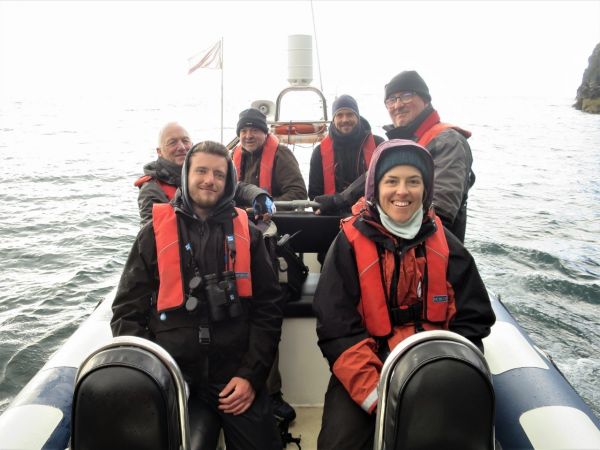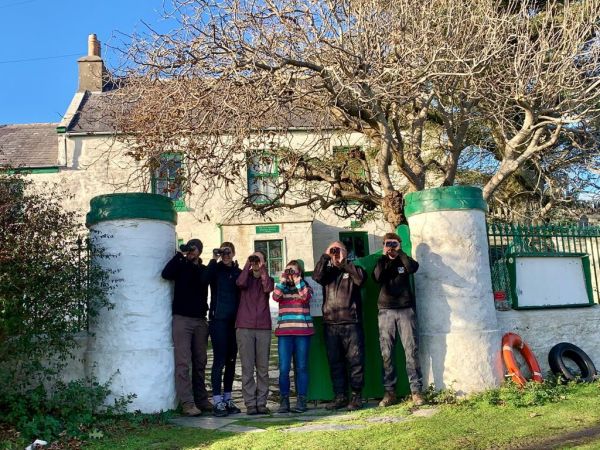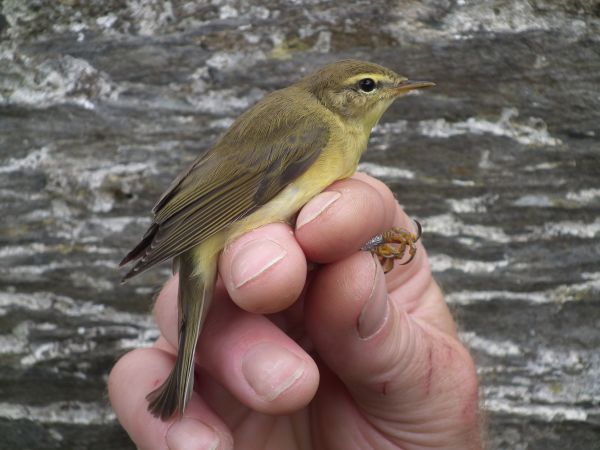On World Migratory Bird Day (8th May), we speak with Aron Sapsford, Manx Wildlife Trust's Ornithological Warden at the Calf of Man Bird Observatory, about its role.
What role does the Calf of Man Bird Observatory play in protecting and monitoring migrating birds?
The Calf of Man is one of 20 accredited bird observatories that are situated around the coastline of the British Isles and Ireland. The data that we collect is brought together by the British Trust for Ornithology (BTO) and is used to identify long-term changes in bird populations and demographics, which, in turn, inform conservation decision making on a national and international scale.
When does your monitoring season run to and from?
Usually, early March to early November
How many people are on the Calf each summer and what does your day to day work involve?
There are currently two bird wardens and two estate wardens.

Wardens and volunteers travelling to the Calf in April 2021
Our bird warden day usually starts around dawn as this is when the greatest level of bird migration occurs. A census of the bird numbers and species is carried out each day, as well as catching birds (under licence) for ringing.
This will normally occupy us until mid-day. Other species specific studies are carried out, particularly during the breeding season.
All of the data needs to be written up each day and information sent to various organisations. A ‘daily log’ is completed at 8.30pm each day, when all the records for the day are recorded onto computer, including birds, mammals, invertebrates and flora. Several species of bird are nocturnal in their habits, so time is also allocated to survey these at night.

Wardens at their house
Estate wardens carry out habitat management of the nature reserve and maintenance of the infrastructure, harbours building, etc. Manx National Heritage has a dormitory on the Calf that the wardens also prepare, and carry out repairs to, and they assist with day visitors and overnight guests.
What are your common migrant birds – and more unusual migrants?
Goldcrest, Willow Warbler and Meadow Pipit are most common visitors. The Calf of Man has recorded over 60 species that were ‘new’ for the Isle of Man. A Mourning Dove in October 1989 was the first ever recorded outside of America.
-copy.jpg)
Mourning Dove
How has the 2021 season started – and have you had any unusual sighting far?
The 2021 season was rather delayed due to the third Covid lockdown. We were due to come out on 9th March but eventually got here on 21st April. A Hobby spotted on 25th April was just the 25th record of one - and the earliest ever - on the Calf.
How do you overcome the geographic and technical restrictions – and survive the sometimes bleak weather?
Supplies are brought over by boat each Tuesday. We have WiFi that allows us to maintain and receive communications with the outside world. Although there is a TV, we don’t often watch it, as getting up at dawn every day means that you are ready for bed quite early. There is always plenty of report writing and data to input, which occupies us during inclement weather. Storms can often be productive and bring unusual species to our shores, so, while most folk would be sheltering, we are often out there sea-watching.

Willow Warbler
What advances in bird monitoring are there – and how are these assisting conservation?
We have recently purchased a thermal imaging camera through sponsorship by Curraghs Wildlife Park Conservation Fund. This is allowing us to survey the nocturnal activities of Manx Shearwaters - which had been lost as a breeding species from the Calf. Numbers are recovering following a recovery project led by Manx National Heritage and Manx Wildlife Trust and the thermal camera will help in establishing a more accurate picture of the numbers that now breed here.
What is it like working on a tiny rock off the main Isle of Man?
Life on the Calf could potentially be quite lonely. However, we have a number of regular volunteers as well as visitors staying with us that always make it a lively and fun place to be. No day is ever the same and there always new challenges and experiences to have.
Watch 'The Calf of Man: the Little Island with the Big Story' - part of a tri-Biosphere webinar series between UNESCO Biosphere Isle of Man, Kerry Biosphere and Dublin Bay Biosphere marking the 50th anniversary of the UNESCO Man and the Biosphere Programme.


